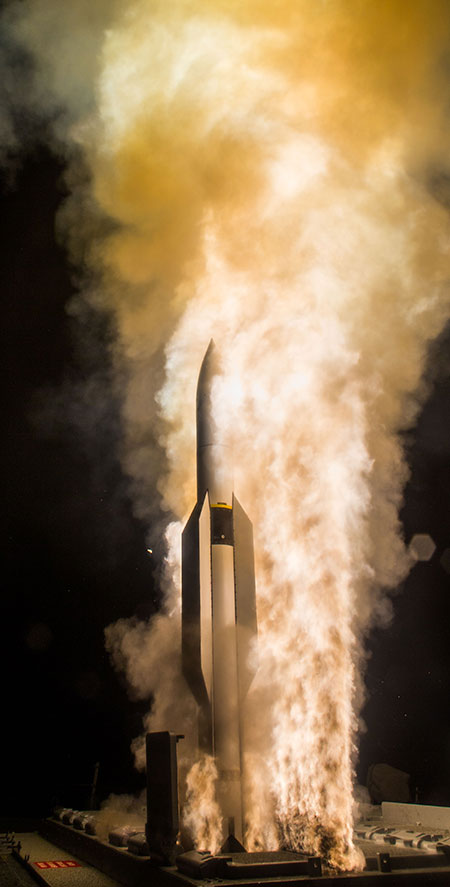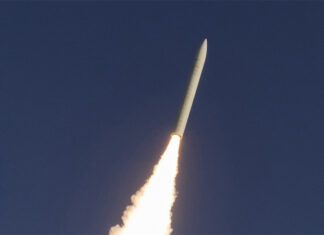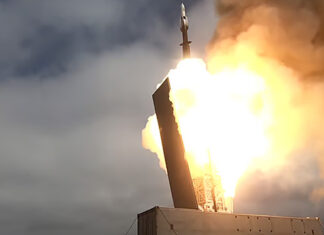
The U.S. Navy yesterday performed a first intercept test of a medium-range ballistic missile target using the new Standard Missile 6 dual mission (SM-6 Dual I) interceptor. The missile was launched by USS John Paul Jones (DDG 53), an Aegis baseline 9.C1 equipped destroyer, supporting the Missile Defense Agency (MDA) AEGIS Missile Defense tests. “The test met its primary objective,” the agency said in a statement. Program officials will continue evaluating system performance based upon telemetry and other data obtained during the test.
“This test demonstrated the capabilities MDA and the Navy are delivering to our fleet commanders,” said MDA Director Vice Adm. Jim Syring. “The SM-6 missile and the Aegis Weapon System continue to prove that they are critical components of our nation’s multilayered, robust ballistic missile defense system.”
The destroyer fired a salvo of two SM-6 Dual I missiles against a complex medium-range ballistic missile (MRBM) target, demonstrating the sea-based terminal endo-atmospheric defensive capability of the vessel. The test was conducted off the coast of Hawaii just after midnight on Dec. 14.
The SM-6 missile uses an explosive warhead to defeat ballistic missile threats, differing from other missile defense interceptors, such as the Standard Missile-3, which use non-explosive hit-to-kill technology. This intercept is the first time the SM-6 ‘Dual I’ engages an MRBM target.
Unlike the AEGIS ships equipped with the SM-3 interceptor that can defend land masses from against ballistic missile attacks, vessels equipped with the SM-6 are designed to defend themselves, and the carrier task forces they are assigned to protect, against all aerial threats. The updated threat assessment calls for defense against a wide range of targets – from manned and unmanned aircraft, guided missiles launched from surface ships, submarines or aircraft at stand-off range, to ballistic ‘carrier killers’ missiles, such as the Chinese DF-21, that may be launched from ranges of 2,000 away, against enemy surface vessels and aircraft carriers. Intercepting such targets, attacking from steep angles, at a velocity of Mach 10, the navy has tasked dedicated interceptors that were not useful for other purposes.
The SM-6 has been developed with this threat in mind – and upgraded to successfully engage land-attack anti-ship cruise missiles in flight; ballistic missiles in their terminal, or final, stage of flight over land or sea; as well as surface targets (floating ships or land targets). The missile will succeed the SM-2 Block IV missile currently used as a dedicated ballistic missile interceptor on AEGIS surface ships.
Vertically launched from an MK 41 VLS canister, the SM-6 missile is compatible with existing AEGIS cruisers and destroyers and future cruisers and destroyers. The system’s operational modes include semi-active homing and active homing to provide highly accurate target engagement, and it incorporates the advanced signal processing and guidance control capabilities of the AMRAAM air-to-air missile.
But the initial version of the SM-6 did not have a capability against ballistic missiles. The SM-6 is to be given a terminal-phase anti-ballistic missile capability in two phases. The first (Sea-Based Terminal – SBT Increment 1) is designated the ‘Dual I’ upgrade that adds a more powerful processor that runs more sophisticated targeting software to hit a warhead descending from the upper atmosphere at extreme speed. The second phase planned for 2018-2019 will include classified capabilities to be included in the ‘Dual II’ configuration.
The U.S. Navy fired an SM-6 “Dual-I” missile in July 2015 for the first time. three ‘Multi-Mission Warfare’ (MMW) tests were conducted that year – successfully demonstrating intercepts of a short-range ballistic missile, supersonic high-diver and subsonic, low-altitude cruise missile targets. The “Dual 1” is part of the Missile Defense Agency’s Sea-Based Terminal program and is slated for additional testing. It will succeed the SM-2 Block IV missile.
Other upgrades to the system to further integrate into the Naval Integrated Fire Control-Counter Air concept (NIFC-CA). In September 2016 the U.S. Navy further expanded the integration of SM-6 weapon system, targeting the weapon with information provided from an airborne F-35B joint strike fighter. Performed at the Navy’s Aegis test site at the White Sands Missile Range, New Mexico, the test tasked a standard Marine Corps F-35B that provided early warning and target detection to the AEGIS system, communicating via it’s stealthy and jam-proof MADL datalink. The AEGIS launched an SM-6 missile that struck the Beechcraft MQM-107 target representing an adversarial fighter. Using any variant of the F-35 as a broad area sensor, the aircraft can significantly increase the Aegis capability to detect, track and engage.
While MADL-AEGIS links have yet to be fielded, Lockheed Martin has already demonstrated such interface to the AEGIS Baseline 9 systems.
Combining the missile defense with traditional air defense capabilities in the same package the SM-6 Dual-I will increase air defense capabilities of these vessels. The upgraded configuration was scheduled to reach initial operational capability in 2016 but such status has not been announced yet.



















